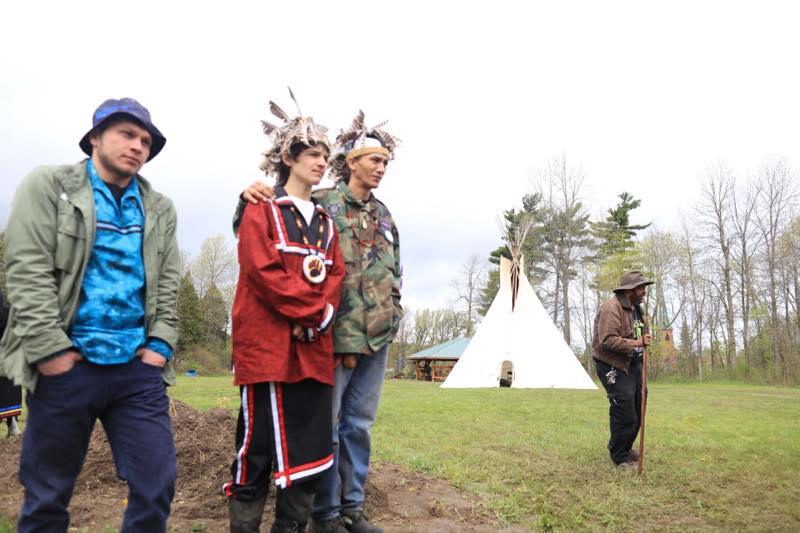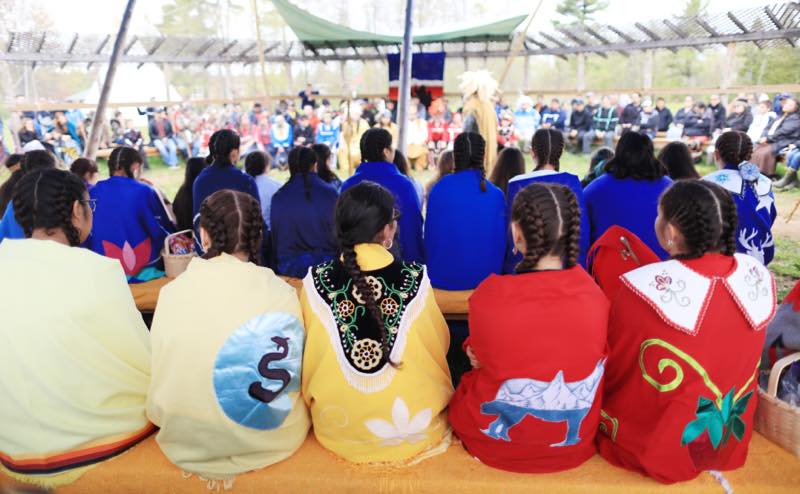A few weeks ago I witnessed a beautiful group of young Haudenosaunees complete their rites of passage through Ohero:kon (o-ho-lo-go), where they emerged from “under the husk” as fully self-actualized, honorable young adults—a truly rare experience for this day and age.
It’s a wonderful thing to watch aunties, uncles, clan mothers, chiefs, mama bears and younger siblings groom young people to become Onkehonwe: the real people—young indigenous thinkers who provide so much hope for our future generations.
Ohero:kon is not an easy process. It’s a four-year commitment during which nieces and nephews will gather every Sunday in the longhouse for 20 weeks throughout the winter months to prepare themselves for adulthood. They will learn to build a fire using traditional sparked flint and dry grass; they will listen to advice from their elders on topics ranging from intergenerational trauma, to traditional health and wellness practices, to how to foster healthy, loving relationships. They will plant seeds and tend traditional three-sister gardens of corn, beans and squash. They will make regalia, learn their traditional songs and practice their own indigenous languages. But maybe most important, they will learn their own strength and go on spiritual fasts in the woods until they are eventually ready, in their fourth year, to spend four days and four nights in the woods without food, drink or contact.
The aunties and uncles will prepare them with incredible care. Just as a farmer tends to his seeds—watering, singing, grooming and ensuring light—so will the aunties and uncles tend to their precious seedling nieces and nephews. They will help them choose their places in the woods, help them build their lodges, protect them with sacred tobacco, and while they fast, will tend the fire and look to the tree people to watch over their beloved children.
Most of the preparations will commence at a place called Kaneni:io [gan-a-he-yo: good seed] or down the road at Tsionkwanatiio [joan-gwan-a-dee-yo], beautiful facilities nestled along the Saint Lawrence river. And the spaces feel epic. Think back to those beautiful scenes of the Shire, hobbit land, in the first Lord of The Rings movie, and you will kind of get the mental picture: Rolling hills hug luscious bright green trees where massive fields of fresh grass and fertile gardens all seem to touch the sky. At one point, Kaneni:io was going to be the new site for the Freedom School, until funding wasn’t achieved, and development was halted, leaving it a mostly finished, barn-like space full of sprouting seeds under ultraviolet light, braided corn hanging from every wall, and several workstations for gourd-painting, stick- carving, moccasin-making and corn-grinding. I understand that it still serves as a community space for the growing and nourishment of all kinds of things, including children. It’s an indigenous woman’s dream, with a fireplace, a sweat lodge and traditional arbor in the back yard.

Matika Wilbur
Mohawk youth opt to spend four years in rigorous training for adulthood.
Of course, Ohero:kon wasn’t realized overnight. It has been developing organically over the past 14 years. It was the vision brought to fruition by many—Louise Wakerakats:te Bear in particular, known to many by her moniker, Mama Bear.
“The need for Ohero:kon came at a time when our community had a lot of social distress,” Bear said. “It was just through the prayers of mothers wanting to do something different that we formalized Ohero:kon.”
(Editor’s Note: In an earlier version of this piece, for brevity’s sake, we neglected to recognize the contributions of Turtle Clanmother Delia Cook for this revival and carrying out rites of passage for previous generations. Those who benefited from her guidance and tutelage have asked us to include as a matter of honor and respect, of which she is certainly more than worthy. Respect and honor, too, for all of the other teachers who since time immemorial have carried out various coming-of-age ceremonies.)
Bear explains that the rites of passage ceremony was given in the original Haudenosaunee creation story, a tradition that has been happening since the beginning of time:
“It happened in Skyworld,” she said. “An uncle takes his sister’s children when he realized that they were children of destiny…so he set them aside from the rest and put them under the husk,” covering them the way corn ears are swathed in their husks, because they were destined to fulfill a prophecy.
“In our language we call corn o’he: ra which means ‘it’s fully husked,’ ” said Bear. “It’s not until the corn is ripe that you begin to peel back the layers of husk to get to the regenerative seed. When our children hit puberty, we begin to pull back the layers and equip them with knowledge about who they are. A big part of Ohero:kon is to offer them knowledge about their creation story so they can understand the genesis of our selves . . . so they know who they are before they become influenced by other people.”
Co-founder, educator and filmmaker Katsitsionni Fox said that Ohero:kon was created as a change agent for Akwesasne.
“It was something we could do for the youth to keep them away from drugs, teen pregnancy, self-harm, all those things that are going on in our communities,” Fox said.
Bear delved into Mohawk history to retrieve the ceremony, said Fox, gathering knowledge keepers together and plumbing dreams.
“The youth who fully commit to the Ohero:kon will learn their purpose in life at a younger age,” Fox said. It’s a tough program, she emphasized, with not all of them making it through.
“Sometimes they will make it one year, then they won’t come back,” Fox said. “It’s the ones that are really invested that will stay for all four years.”
For those who stick it out, “it really alters their path,” she said. “It makes them find their purpose sooner. They don’t waste a lot of time.”
Being in ceremony together brings them closer, connecting them with each other and the community, Fox added. Fox has made a beautiful film about the program, including a trailer.
Once the fourth-years come out of their fast, they look shiny and new, glowing with accomplishment and a radiance that is hard to describe. At their graduation ceremony, the fourth-year nieces and nephews shared what they’ve learned with tribal leaders.

Matika Wilbur
The graduation ceremony of Mohawk youth into adulthood.
Bear recalled one of her most memorable experiences, with a niece who had a dream about the Thunder Beings.
“In this dream, or vision, she met the Thunder Beings, and they told her their names in the Mohawk language, and we were able to record that and revitalize those names,” said Bear. “And now, when we burn tobacco for the Thunder Beings in the spring and in the fall, we acknowledge those names.”
Several of the nieces and nephews even brought back stories to encourage their people to return to traditional food systems, Bear said.
One of the nephews this year dreamed that he came out of his fast and went to the sacred fire and nobody was there, so he went to kaneni:io and found it also empty, and then he went to the longhouse and nobody was there either. He realized that all of the culture bearers were gone, that he would have to carry the culture forward, that he was the last one. Then he woke up, grateful to know there were still culture bearers to guide him, and grateful that he will be able to carry his culture forward.
Ohero:kon has become a driving force mobilizing the community, Bear said, and has healed a lot of divisions as the community committed to working together “for the love of our children,” she said. “Ohero:kon reduced the crime rate. It reduced teen pregnancy. It reduced juvenile delinquency. But most important, it also returned a lot of young people back to our longhouses.”
O:herokon is about planting seeds. Seeds of knowledge. Seeds of hope. Seeds that make leaders. Or as my beautiful niece Quinna Hamby describes it, “It connected me to community. I know that my community will always forgive me. That I can go back to them. I know that I am a traditional person, and even though I might be going away to college, I can always come home.”

Matika Wilbur
The ceremony for Mohawk youth completing a four-year coming-of-age ritual to bring them to adulthood.
© 2017 Indian Country Today Media Network, all rights reserved. https://indiancountrymedianetwork.com
https://indiancountrymedianetwork.com/culture/health-wellness/youth-akwesasne-under-husk/
